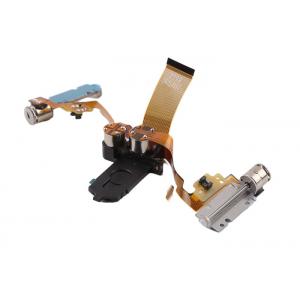
Add to Cart
IRIS detects the intensity of the light through the sensor inside the camera. According to the calculation, the system determines the degree to which the aperture needs to be opened. The system controls the engine in the IRIS lens to dynamically and precisely control the aperture size. So as to achieve the best photo effect .
This product is a dual-drive integrated (IRIS & IR-CUT) IRIS: two blades, one is blue glass, the other is AR glass, connected with IR-cut through a carrier, which can realize different filter modes. The engine is connected through FPC and hall sensor, which can dynamically and accurately adjust the size of the aperture.
P-IRIS controls the aperture size dynamically and precisely by controlling the stepper motors in the P-IRIS lens. Unlike DC-IRIS, where the main task is to constantly adjust the aperture size, the main purpose of P-IRIS is to set the optimal aperture position, so that most of the center of the lens and the part with the best effect are used, and the optical error in this position is large. reduce. small, thereby improving image quality. P-IrIS requires the use of gain and exposure time to manage small changes in light to further optimize image quality, maintaining the optimal aperture position for as long as possible. However, when the ability to adjust gain and exposure time is exceeded, P-IRIS will adjust the iris to a different position. This product is a dual drive integrated (IRIS & IR-CUT) IRIS: two blades, FPC connection (including HALL) IR-CUT: one switch plate, one blue glass, one AR glass, FPC connection
1) Camera
2) Optical instruments
3) Precision medical devices
4) Automatic door locks
Other precise control application
| Model No. | VIRIS107-13 motor |
| Motor type | IRIS ir cut |
| Phase No. | 2 phases |
| Step angle | 18 degrees |
| Phase resistance | 81 Ohms/phase |
| Excitation method | 2-2 bipolar drive |
| Rated voltage | 5 - 12 V DC |
| Lead screw type | M2P0.4 |
| Stroke | 21mm |
| Pull-out thrust | Over 1.8 g.cm at 960PPS |
| Pull-in torque | Over 1.6g.cm at 960PPS |

IRIS working principle:

Product display:

1. question:What is IR-CUT
Answer:The IR-CUT can be simply understood as the "glasses" of CMOS, which includes "glasses" and "glasses removal device", "glasses" is the filter, "glasses removal device" is the IR-CUT mechanical structure.
Igenerally, The lens has 2 pieces glass and a carriage , one piece is used to filter out infrared light in the daytime, and the other piece is used for full light transmission at night. The two lens are controlled by an IR-CUT motor (or other types of engines), and take turns to work. In the daytime, the infrared filter is used to prevent the image from being biased. At night, the full transparency is used to improve the sensitivity. IR=infrared=infrared
CUT = filter, subtract
2. question:When to use IR-CUT
Answer:IPC network cameras generally have high requirements for images, requiring that the images be not biased in the daytime, and the night vision effect is good with infrared lights at night, and IR-CUT is required.
3. question:Special requirement for using IR-CUT
Answer: When using IR-CUT with infrared light, a synchronization signal must be output from the light board to the CMOS board to "tell" the CMOS board whether the infrared light is currently on or off. Required for all CMOS with IR light with IR-CUT